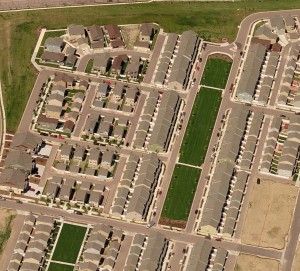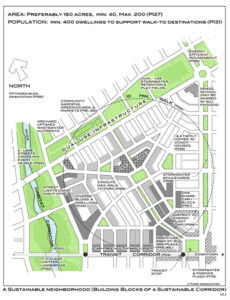The City of Colorado Springs includes three neo-traditional neighborhood developments (TND’s) to date: Spring Creek; Lowell; and Gold Hill Mesa. A driving factor in incorporating new urbanism in Colorado Springs was the creation of Colorado Springs’ TND zoning overlay (Part 1; Part 2), which is guided by a document of standards, policies and guidelines. The document outlines many of the standards of a modern-day form-based code and includes a vital section on context-sensitive streets, which due to a collaborative effort between designers and local officials and organizations (Traffic, Public Works, Fire Department, etc.), enabled smaller street widths than the city would normally allow. Examples of the standard street widths in the TND zoning overlay include:
• 16-ft wide Alleys
• 22-ft wide Lanes (two-way yield streets with on-street parking on one side)
• 28-ft wide “TND Streets” (two-way yield streets with on-street parking on both sides)

Spring Creek is one of the two large-scale neo-traditional neighborhood developments in Colorado Springs. It is located on a 135-acre site located southeast of downtown Colorado Springs – east of Union Boulevard and south of the Martin Luther King Bypass (Highway 24). The neighborhood is conveniently located within a 5-minute drive to downtown (or 15 minute bicycle ride), and 10-minutes from The Broadmoor, Fort Carson and Manitou Springs. The neighborhood is walkable, with connections to nearby commercial uses, and rich in residential diversity. Multiple home typologies and affordability ranges in the neighborhood create a sustainable future that is unmatched by conventional suburban development. Accessory Dwelling Units in the form of “Granny Flats”, Condominiums, Row Houses, Town Houses, and Detached Single-Family Homes are all available in the neighborhood. This housing stock creates a range of housing prices, available in rentals or ownership, which supports a range of income levels and mixed demographics. Residents are able to age in place and remain in the neighborhood as their lives evolve. Even in the neighborhood’s short life, young residents have moved from townhomes to detached single-family homes to start a family, and empty nesters have downsized from larger two-story homes to smaller ranch homes.
Spring Creek was designed and built on a greenfield previously slated for a regional mall in Colorado Springs. It is adjacent to a commercial and multi-family housing development built in the 1970s and 80s. Prior to the development of Spring Creek, the adjacent shopping center was vacant but has since opened a popular Hispanic grocery store, Rancho Liborio ‘Su Mercado’, as well as ancillary stores and restaurants such as a local liquor store, a Dollar Tree and Subway. The grocery store was greeted with enthusiasm by the neighborhood and is conveniently located within short walking distance from the neighborhood. It is common to see residents walking to and from the grocery store to pick up personal items. The neighborhood also includes its own K-8 community school which was also traditionally designed and constructed as a two-story building, salvaging valuable land.

Spring Creek is a beautiful neighborhood with spectacular amenities and great infrastructure, similar in many ways to our historic neighborhoods. It is a neighborhood, like most TND’s across the country, that will become better with age and maturity. Its diverse housing stock and adjacent walkable amenities offer a sustainable component which will contribute to the livability of the neighborhood over the coming decades.








